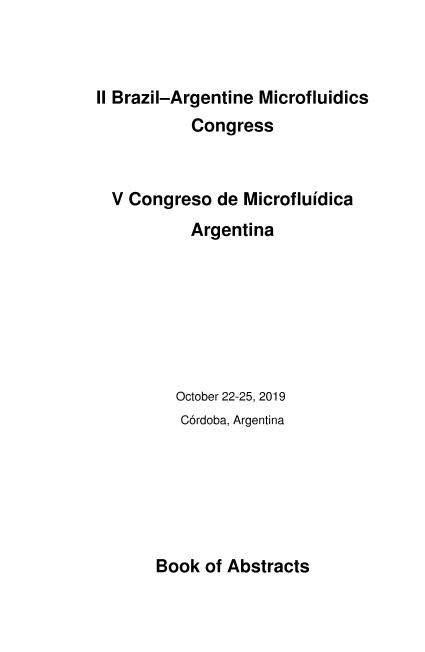Mostrar el registro sencillo del ítem
dc.contributor.author
Fonseca, A.
dc.contributor.author
Bilen, Marcos Fabian

dc.contributor.author
Olivares, María Laura

dc.contributor.author
Marengo, Robinson Cristian

dc.contributor.author
Berli, Claudio Luis Alberto

dc.contributor.author
Borio, Cristina Silvia

dc.contributor.other
Marconi, Verónica I.
dc.contributor.other
Banchio, Adolfo J.
dc.date.available
2021-07-15T16:04:07Z
dc.date.issued
2019
dc.identifier.citation
Microfluidic-free encapsulation of bacteria for isothermal DNA amplification; II Brazil-Argentine Microfluidics Congress y V Congreso de Microfluídica Argentina; Córodoba; Argentina; 2019; 1-6
dc.identifier.isbn
978-987-779-009-2
dc.identifier.uri
http://hdl.handle.net/11336/136221
dc.description.abstract
Linking genotype (a nucleic acid that can be replicated) and phenotype (a functional trait, such as a binding or catalytic or regulatory activity) in a unique compartment is a key aspect of protein functional analysis, because emulates the natural genotype-to-phenotype linkage that results from the compartmentalization of genes in cells.This connection is easy to obtain when the number of samples is below 100, but when the number of samples rises to the order of millions, a technical problem appears. A solution to this limitation is the miniaturization and parallelization of the process, associated with the formation of aqueous nanocompartments, like aqueous droplets in oil phases. This methodology converts the analysis into ultra-high-throughput, since is possible to obtain compartments of small sizes as 100 mm and volumes of nearly 1 nanolitre. This high capacity (>1010 droplets in 1 ml of emulsion), the ease of preparing emulsions and their high stability over a broad range of temperatures, pH and salt concentrations, makes this methodology ideal for compartmentalizing biochemical and genetic assays.In this sense, the nanocompartmentalization of bacteria is an optimal tool for in vitro evolution analysis, with the only condition that it is possible to confine a single bacteria per compartment. To do this in a conventional system the water-in-oil emulsion formation parameters, must be considered.In this study, parameters like bacterial DO600 and vortex speed where evaluated in order to obtain particles of average size of 100mm containing a bacteria or none inside. Bacterias expressing a DNA polymerase were used to study the isothermal DNA amplification inside these particles, by DNA recovery and fluorescence detection. Here we also report on preliminary studies towards microfluidic generation of microdroplets. A PMMA chip with a cross-junction was used to obtain W/O emulsion, with fluids fed by syringe pumps.
dc.format
application/pdf
dc.language.iso
eng
dc.publisher
Universidad Nacional de Córdoba
dc.rights
info:eu-repo/semantics/openAccess
dc.rights.uri
https://creativecommons.org/licenses/by-nc-sa/2.5/ar/
dc.subject
ENCAPSULATION
dc.subject
DNA AMPLIFICATION
dc.subject
MICROFLUIDIC
dc.subject
MICROPARTICLES
dc.subject.classification
Nano-procesamiento

dc.subject.classification
Nanotecnología

dc.subject.classification
INGENIERÍAS Y TECNOLOGÍAS

dc.title
Microfluidic-free encapsulation of bacteria for isothermal DNA amplification
dc.type
info:eu-repo/semantics/publishedVersion
dc.type
info:eu-repo/semantics/conferenceObject
dc.type
info:ar-repo/semantics/documento de conferencia
dc.date.updated
2021-06-24T16:26:27Z
dc.journal.pagination
1-6
dc.journal.pais
Argentina

dc.journal.ciudad
Córodoba
dc.description.fil
Fil: Fonseca, A.. Universidad Nacional de Quilmes; Argentina
dc.description.fil
Fil: Bilen, Marcos Fabian. Universidad Nacional de Quilmes; Argentina. Consejo Nacional de Investigaciones Científicas y Técnicas; Argentina
dc.description.fil
Fil: Olivares, María Laura. Consejo Nacional de Investigaciones Científicas y Técnicas. Centro Científico Tecnológico Conicet - Santa Fe. Instituto de Desarrollo Tecnológico para la Industria Química. Universidad Nacional del Litoral. Instituto de Desarrollo Tecnológico para la Industria Química; Argentina
dc.description.fil
Fil: Marengo, Robinson Cristian. Consejo Nacional de Investigaciones Científicas y Técnicas. Centro Científico Tecnológico Conicet - Santa Fe. Instituto de Desarrollo Tecnológico para la Industria Química. Universidad Nacional del Litoral. Instituto de Desarrollo Tecnológico para la Industria Química; Argentina
dc.description.fil
Fil: Berli, Claudio Luis Alberto. Consejo Nacional de Investigaciones Científicas y Técnicas. Centro Científico Tecnológico Conicet - Santa Fe. Instituto de Desarrollo Tecnológico para la Industria Química. Universidad Nacional del Litoral. Instituto de Desarrollo Tecnológico para la Industria Química; Argentina
dc.description.fil
Fil: Borio, Cristina Silvia. Universidad Nacional de Quilmes; Argentina. Consejo Nacional de Investigaciones Científicas y Técnicas; Argentina
dc.relation.alternativeid
info:eu-repo/semantics/altIdentifier/url/https://www.mfarg.org/book-of-abstracts
dc.conicet.rol
Autor

dc.conicet.rol
Autor

dc.conicet.rol
Autor

dc.conicet.rol
Autor

dc.conicet.rol
Autor

dc.conicet.rol
Autor

dc.coverage
Internacional
dc.type.subtype
Congreso
dc.description.nombreEvento
II Brazil-Argentine Microfluidics Congress y V Congreso de Microfluídica Argentina
dc.date.evento
2019-10-22
dc.description.ciudadEvento
Córodoba
dc.description.paisEvento
Argentina

dc.type.publicacion
Book
dc.description.institucionOrganizadora
Universidad Nacional de Córdoba. Facultad de Matemática, Astronomía, Física y Computación
dc.source.libro
Book of abstracts II Brazil-Argentine Microfluidics Congress y V Congreso de Microfluídica Argentina
dc.date.eventoHasta
2019-10-25
dc.type
Congreso
Archivos asociados
